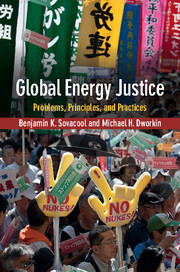Book contents
- Frontmatter
- Epigraph
- Dedication
- Contents
- Analytical table of contents
- List of figures
- List of tables
- Acknowledgements
- List of abbreviations
- 1 Introduction
- 2 The global energy system
- 3 Virtue and energy efficiency
- 4 Utility and energy externalities
- 5 Energy and human rights
- 6 Energy and due process
- 7 Energy poverty, access, and welfare
- 8 Energy subsidies and freedom
- 9 Energy resources and future generations
- 10 Fairness, responsibility, and climate change
- 11 The imperative of making just energy decisions
- Index
- References
6 - Energy and due process
Published online by Cambridge University Press: 05 October 2014
- Frontmatter
- Epigraph
- Dedication
- Contents
- Analytical table of contents
- List of figures
- List of tables
- Acknowledgements
- List of abbreviations
- 1 Introduction
- 2 The global energy system
- 3 Virtue and energy efficiency
- 4 Utility and energy externalities
- 5 Energy and human rights
- 6 Energy and due process
- 7 Energy poverty, access, and welfare
- 8 Energy subsidies and freedom
- 9 Energy resources and future generations
- 10 Fairness, responsibility, and climate change
- 11 The imperative of making just energy decisions
- Index
- References
Summary
In 2000 and 2001, during the height of the California electricity crisis, the City of San Diego faced consistent rolling brownouts and electricity shortages. Fearing that the predicament was a taste of things to come, city planners, in association with the local utility San Diego Gas and Electric (SDG&E) and the California Independent Systems Operator, proposed creating a $130 million, 100-mile-long high-voltage (500 kV) above ground transmission line to connect the Valley Substation with the Rainbow Substation. Backed by these supporters, the Valley-Rainbow Interconnect Project had a number of large potential benefits. It would increase SDG&E’s ability to import electricity into their service area by approximately 700 MW. The project would help interconnect SDG&E’s network with that of Southern California Edison. It would improve system reliability, minimizing the risk of future blackouts, especially given that Riverside County, and the Project area as a whole, was at the time one of the fastest-growing places in the United States. It had “significant economic benefits to the State” in the form of “significant reductions in energy costs” and “substantial cost benefits to ratepayers” in the form of “avoided customer outage costs,” ultimately benefiting about 3.4 million San Diego customers with improved connectivity and lower spot prices for electricity.
However, despite these possible gains, a collection of smaller cities, community groups, environmental nongovernmental organizations, and Indian tribes staunchly opposed the project. Much of the 100-mile corridor of land needed belonged not to the state, but to private owners and cities. The project required the state to “confiscate” more than 140 properties and roughly 638 acres of land from the cities of Temecula, De Luz, Glen Oaks, Redhawk, Vail Ranch, Oakridge Ranches, Winchester, Wine Country, French Valley, Sun City, Menifee, and Lake Skinner. The Southwest Association of Realtors and the Women’s Council of Realtors protested against the line on the grounds that it would significantly lower property values across 4,600 residential units, 215 acres of commercial development, 167.2 acres of mixed-use development, three school sites, three parks, an eighteen-hole golf course and even a helicopter pilot training school.
- Type
- Chapter
- Information
- Global Energy JusticeProblems, Principles, and Practices, pp. 191 - 222Publisher: Cambridge University PressPrint publication year: 2014
References
- 1
- Cited by

